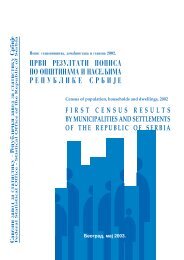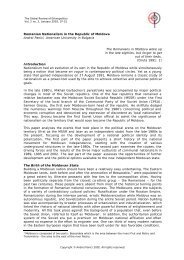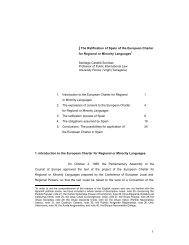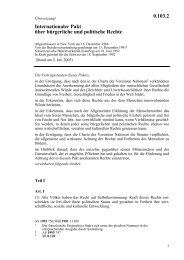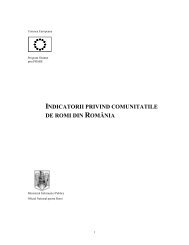Final Report of the International Commission on the - Minority Rights ...
Final Report of the International Commission on the - Minority Rights ...
Final Report of the International Commission on the - Minority Rights ...
You also want an ePaper? Increase the reach of your titles
YUMPU automatically turns print PDFs into web optimized ePapers that Google loves.
investigative methods customary in all ghettos. Am<strong>on</strong>g those involved in <str<strong>on</strong>g>the</str<strong>on</strong>g>se investigati<strong>on</strong>s, under <str<strong>on</strong>g>the</str<strong>on</strong>g><br />
leadership <str<strong>on</strong>g>of</str<strong>on</strong>g> Nagy and Várhelyi, were Károly Balogh and László Berentes, associates <str<strong>on</strong>g>of</str<strong>on</strong>g> <str<strong>on</strong>g>the</str<strong>on</strong>g> Phoenix<br />
Factory <str<strong>on</strong>g>of</str<strong>on</strong>g> Baia Mare, as well as Haracsek, Peter Czeisberger, Zoltán Osváth, and detectives József<br />
Orgoványi, Imre Vajai and István Bertalan. Overall resp<strong>on</strong>sibility for <str<strong>on</strong>g>the</str<strong>on</strong>g> administrati<strong>on</strong> <str<strong>on</strong>g>of</str<strong>on</strong>g> <str<strong>on</strong>g>the</str<strong>on</strong>g> county at<br />
<str<strong>on</strong>g>the</str<strong>on</strong>g> time rested with Barnabás Endrödi, who had been appointed prefect <str<strong>on</strong>g>of</str<strong>on</strong>g> Satu Mare County by <str<strong>on</strong>g>the</str<strong>on</strong>g><br />
Sztójay government <strong>on</strong> April 25, 1944.<br />
The 5,917 Jews in <str<strong>on</strong>g>the</str<strong>on</strong>g>se two ghettos were deported in two transports <strong>on</strong> May 31 and June 5.<br />
Bistriţa. The approximately 6,000 Jews <str<strong>on</strong>g>of</str<strong>on</strong>g> Bistriţa and <str<strong>on</strong>g>the</str<strong>on</strong>g> o<str<strong>on</strong>g>the</str<strong>on</strong>g>r communities in Bistriţa-Năsăud County<br />
were c<strong>on</strong>centrated at <str<strong>on</strong>g>the</str<strong>on</strong>g> Stamboli farm, located about two to three miles from <str<strong>on</strong>g>the</str<strong>on</strong>g> city. Close to 2,500 <str<strong>on</strong>g>of</str<strong>on</strong>g><br />
<str<strong>on</strong>g>the</str<strong>on</strong>g> ghetto inhabitants were from Bistriţa itself. The o<str<strong>on</strong>g>the</str<strong>on</strong>g>rs were brought in from <str<strong>on</strong>g>the</str<strong>on</strong>g> communities in <str<strong>on</strong>g>the</str<strong>on</strong>g><br />
districts <str<strong>on</strong>g>of</str<strong>on</strong>g> Lower Bistriţa and Upper Bistriţa, Năsăud, and Rodna.<br />
The ghettoizati<strong>on</strong> <str<strong>on</strong>g>of</str<strong>on</strong>g> <str<strong>on</strong>g>the</str<strong>on</strong>g> city’s Jews was carried out under <str<strong>on</strong>g>the</str<strong>on</strong>g> command <str<strong>on</strong>g>of</str<strong>on</strong>g> <str<strong>on</strong>g>the</str<strong>on</strong>g> mayor Norbert Kuales<br />
and police chief Miklós Debreczeni. In <str<strong>on</strong>g>the</str<strong>on</strong>g> o<str<strong>on</strong>g>the</str<strong>on</strong>g>r communities <str<strong>on</strong>g>of</str<strong>on</strong>g> <str<strong>on</strong>g>the</str<strong>on</strong>g> county <str<strong>on</strong>g>the</str<strong>on</strong>g> roundup was guided by<br />
László Smolenszki, <str<strong>on</strong>g>the</str<strong>on</strong>g> deputy prefect, and Lt. Col. Ernö Pasztai <str<strong>on</strong>g>of</str<strong>on</strong>g> <str<strong>on</strong>g>the</str<strong>on</strong>g> gendarmerie. All four had<br />
attended <str<strong>on</strong>g>the</str<strong>on</strong>g> April 28 c<strong>on</strong>ference with Endre in Târgu Mureş.<br />
The ghetto, c<strong>on</strong>sisting <str<strong>on</strong>g>of</str<strong>on</strong>g> a number <str<strong>on</strong>g>of</str<strong>on</strong>g> barracks and pigsties, was inadequate from every point <str<strong>on</strong>g>of</str<strong>on</strong>g> view.<br />
The very poor water and food supply was in large part due to <str<strong>on</strong>g>the</str<strong>on</strong>g> vicious behavior <str<strong>on</strong>g>of</str<strong>on</strong>g> Heinrich Smolka,<br />
who was in charge. Am<strong>on</strong>g those who cooperated with Smolka in <str<strong>on</strong>g>the</str<strong>on</strong>g> persecuti<strong>on</strong> <str<strong>on</strong>g>of</str<strong>on</strong>g> <str<strong>on</strong>g>the</str<strong>on</strong>g> Jews was<br />
Gusztáv Órendi, a Gestapo agent in Bistrita. The local police authorities were assisted in guarding <str<strong>on</strong>g>the</str<strong>on</strong>g><br />
ghetto by 25 gendarmes from Dumitra, who had been ordered to Bistrita by Col. Paksy-Kiss. After May<br />
10, 1944 <str<strong>on</strong>g>the</str<strong>on</strong>g> prefect <str<strong>on</strong>g>of</str<strong>on</strong>g> <str<strong>on</strong>g>the</str<strong>on</strong>g> county was Kálmán Borbély.<br />
The deportati<strong>on</strong> <str<strong>on</strong>g>of</str<strong>on</strong>g> <str<strong>on</strong>g>the</str<strong>on</strong>g> 5,981 Jews in Bistrita took place <strong>on</strong> June 2 and 6, 1944.<br />
Oradea. The largest ghetto in Hungary—except for <str<strong>on</strong>g>the</str<strong>on</strong>g> <strong>on</strong>e in Budapest—was that <str<strong>on</strong>g>of</str<strong>on</strong>g> Oradea.<br />
Actually, Oradea had two ghettos: <strong>on</strong>e for <str<strong>on</strong>g>the</str<strong>on</strong>g> city’s Jews, holding approximately 27,000 people and<br />
located in <str<strong>on</strong>g>the</str<strong>on</strong>g> neighborhood <str<strong>on</strong>g>of</str<strong>on</strong>g> <str<strong>on</strong>g>the</str<strong>on</strong>g> large Orthodox synagogue and <str<strong>on</strong>g>the</str<strong>on</strong>g> adjacent Great Market; <str<strong>on</strong>g>the</str<strong>on</strong>g> o<str<strong>on</strong>g>the</str<strong>on</strong>g>r,<br />
for <str<strong>on</strong>g>the</str<strong>on</strong>g> close to 8,000 Jews brought in from <str<strong>on</strong>g>the</str<strong>on</strong>g> many rural communities from <str<strong>on</strong>g>the</str<strong>on</strong>g> following twelve<br />
districts: Aleşd, Beretttyóújfalu (now Hungary), Biharkeresztes (now Hungary), Cefa, Derecske (now<br />
Hungary), Marghita, Oradea, Săcueni, Sălard, Sal<strong>on</strong>ta Mare, Sárrét (now Hungary), and Valea lui Mihai.<br />
Many <str<strong>on</strong>g>of</str<strong>on</strong>g> <str<strong>on</strong>g>the</str<strong>on</strong>g> Jews from <str<strong>on</strong>g>the</str<strong>on</strong>g>se communities were c<strong>on</strong>centrated in and around <str<strong>on</strong>g>the</str<strong>on</strong>g> Mezey Lumber Yards.<br />
The ghetto <str<strong>on</strong>g>of</str<strong>on</strong>g> Oradea was extremely overcrowded. The Jews <str<strong>on</strong>g>of</str<strong>on</strong>g> <str<strong>on</strong>g>the</str<strong>on</strong>g> city, who c<strong>on</strong>stituted about 30<br />
percent <str<strong>on</strong>g>of</str<strong>on</strong>g> its populati<strong>on</strong>, were crammed into an area sufficient for <strong>on</strong>ly <strong>on</strong>e-fifteenth <str<strong>on</strong>g>of</str<strong>on</strong>g> <str<strong>on</strong>g>the</str<strong>on</strong>g> city’s<br />
inhabitants. The density was such that 14 to 15 Jews had to share a room. Like every o<str<strong>on</strong>g>the</str<strong>on</strong>g>r ghetto, <str<strong>on</strong>g>the</str<strong>on</strong>g><br />
ghetto <str<strong>on</strong>g>of</str<strong>on</strong>g> Oradea suffered from a severe shortage <str<strong>on</strong>g>of</str<strong>on</strong>g> food; <str<strong>on</strong>g>the</str<strong>on</strong>g>y also were <str<strong>on</strong>g>the</str<strong>on</strong>g> victims <str<strong>on</strong>g>of</str<strong>on</strong>g> <str<strong>on</strong>g>the</str<strong>on</strong>g> punitive<br />
measures <str<strong>on</strong>g>of</str<strong>on</strong>g> an especially vicious local administrati<strong>on</strong>. The anti-Semitic city government <str<strong>on</strong>g>of</str<strong>on</strong>g>ten cut <str<strong>on</strong>g>of</str<strong>on</strong>g>f<br />
electric service and <str<strong>on</strong>g>the</str<strong>on</strong>g> flow <str<strong>on</strong>g>of</str<strong>on</strong>g> water to <str<strong>on</strong>g>the</str<strong>on</strong>g> ghetto. Moreover, under <str<strong>on</strong>g>the</str<strong>on</strong>g> command <str<strong>on</strong>g>of</str<strong>on</strong>g> Lt. Col. Jenõ<br />
Péterffy, <str<strong>on</strong>g>the</str<strong>on</strong>g> gendarmes were especially sadistic in operating <str<strong>on</strong>g>the</str<strong>on</strong>g> local “mint,” which was set up at <str<strong>on</strong>g>the</str<strong>on</strong>g><br />
Dréher Breweries immediately adjacent to <str<strong>on</strong>g>the</str<strong>on</strong>g> ghetto. Internally, <str<strong>on</strong>g>the</str<strong>on</strong>g> ghettos were administered by a<br />
Jewish Council headed by Sándor Leitner, <str<strong>on</strong>g>the</str<strong>on</strong>g> head <str<strong>on</strong>g>of</str<strong>on</strong>g> <str<strong>on</strong>g>the</str<strong>on</strong>g> Orthodox Jewish community.<br />
The deportati<strong>on</strong> <str<strong>on</strong>g>of</str<strong>on</strong>g> <str<strong>on</strong>g>the</str<strong>on</strong>g> Jews began with <str<strong>on</strong>g>the</str<strong>on</strong>g> “evacuati<strong>on</strong>” <str<strong>on</strong>g>of</str<strong>on</strong>g> those c<strong>on</strong>centrated in <str<strong>on</strong>g>the</str<strong>on</strong>g> Mezey Lumber<br />
Yard <strong>on</strong> May 23. This was followed <strong>on</strong> May 28 with <str<strong>on</strong>g>the</str<strong>on</strong>g> first transport from <str<strong>on</strong>g>the</str<strong>on</strong>g> city itself. The last<br />
transport left Oradea <strong>on</strong> June 27.<br />
Ţara Secuilor. In Gendamerie District X, <str<strong>on</strong>g>the</str<strong>on</strong>g> so-called Ţara Secuilor (Szekler Land), which<br />
encompassed Mureş-Turda, Ciuc, Odorheiu, and Trei Scaune counties, <str<strong>on</strong>g>the</str<strong>on</strong>g> Jews were placed in three<br />
major ghettos: Târgu Mureş, Reghin, and Sfântu Gheorghe. The c<strong>on</strong>centrati<strong>on</strong> <str<strong>on</strong>g>of</str<strong>on</strong>g> <str<strong>on</strong>g>the</str<strong>on</strong>g> Jews <str<strong>on</strong>g>of</str<strong>on</strong>g> Ţara




